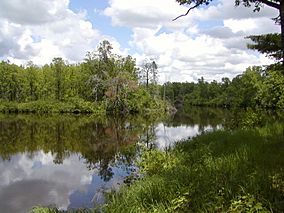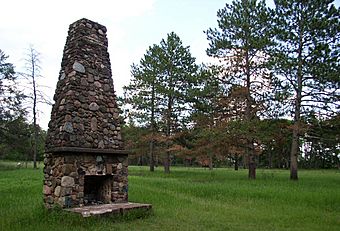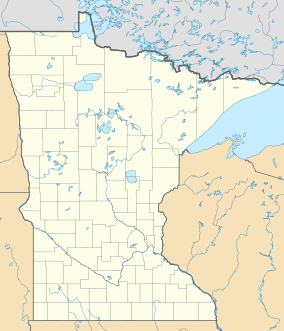Saint Croix State Park facts for kids
Quick facts for kids St. Croix State Park |
|
|---|---|

A lake in Saint Croix State Park
|
|
| Location | Pine, Minnesota, United States |
| Area | 33,895 acres (137.17 km2) |
| Elevation | 935 ft (285 m) |
| Established | 1943 |
| Governing body | Minnesota Department of Natural Resources |
|
St. Croix Recreational Demonstration Area
|
|

The chimney of the recreation hall is the only remains of the Yellowbanks Civilian Conservation Corps camp
|
|
| Nearest city | Hinckley, Minnesota |
|---|---|
| Area | 34,047 acres (13,778 ha) |
| Built | 1936 |
| Architect | National Park Service, Civilian Conservation Corps; George Nason, Edward W. Barber, Edward W., et al. |
| Architectural style | Bungalow/Craftsman, NPS rustic |
| MPS | Minnesota State Park CCC/WPA/Rustic Style MPS |
| NRHP reference No. | 96001594 and 97001261, |
| Significant dates | |
| Added to NRHP | January 31, 1997 (original) September 25, 1997 (revised) |
| Designated NHL | September 25, 1997 |
St. Croix State Park is a large state park in Pine County, Minnesota, USA. It stretches along the St. Croix River for about 21 miles (34 km). It also includes the last 7 miles (11 km) of the Kettle River.
At 33,895 acres (13,717 ha), it is the biggest state park in Minnesota. In the 1930s, it was built as a Recreational Demonstration Area. This was a special program to create parks and jobs during the Great Depression. The park has 164 buildings made by the Civilian Conservation Corps (CCC) and the Works Progress Administration (WPA)]. These are the most buildings from these programs in Minnesota. Because of their history, the park's buildings were named a National Historic Landmark in 1997.
Contents
Nature and Wildlife in St. Croix State Park
The St. Croix River Valley was formed by melting ice from the last glacial period about 12,000 years ago. This melting ice left behind many types of soil in the park. Some soils are very sandy, while others are made of red or yellow clay. The Yellowbanks area, a historic part of the park, gets its name from its bright yellow clay banks.
Most of the park's bedrock is covered by 75 to 100 feet (23 to 30 m) of these glacial deposits. However, in one spot along the Kettle River, called the Highbanks, the underlying basalt and sandstone can be seen. This happened when a huge ancient flood washed away the soil.
Besides the two main rivers, at least ten other streams flow through the park. These streams create a large watershed that covers hundreds of square miles.
Plants and Trees
St. Croix State Park is on the eastern edge of the Mille Lacs Uplands. Long ago, it had many red and white pines. But logging and farming changed the land. Now, the forest has a mix of pines, black spruce, sugar maple, and basswood.
Open areas in the park include meadows, oak savanna, and jack pine barrens. Many lakes, marshes, and streams support plants that grow in wetlands and along riverbanks. Some wet areas with no outlet and high acidity have tamarack bogs.
Animals and Birds
You can find many large animals in the park. These include white-tailed deer, coyotes, raccoons, gray and red foxes, beavers, bobcats, black bears, and timber wolves.
Many birds also live here, such as the ruffed grouse, warblers, flycatchers, eagles, owls, and osprey. These birds often fly along the St. Croix River.
Weather Events
A tornado hit part of the park on July 4, 1977. Strong Straight-line winds knocked down trees across hundreds of acres on July 11, 2008. More strong winds caused damage again on July 1, 2011. In the 2011 storm, many historic buildings were damaged. Luckily, no one was hurt because the park was closed at the time.
History of St. Croix State Park
Native American people lived in the St. Croix River Valley for at least 5,000 years. The Dakota people lived in this area by the late 1600s, when French traders first arrived. Later, the Ojibwe people moved into the region.
Fur Trade and Logging
More fur traders came to the area, and a trading post was set up where the park is now. In 1837, a treaty with the Ojibwe opened the region for logging. Logging in the park started later in the 1800s.
From 1894 to 1898, the Empire Lumber Company used a train line called the Flemming Railroad. This line carried logs cut inland to the St. Croix River. The train stopped at Yellowbanks, where logs were rolled down steep hills into the river. They then floated to sawmills downstream. St. John's Landing, in the park's northeast, is named after Ed St. John. He ran a popular place for lumbermen to stay there.
From Farmland to Park
By 1915, most of the trees had been cut down. Farmers then came to settle on the newly cleared land. However, the sandy soil was not good for farming, and many settlers could not make a living. Most of them moved away, and much of the land was given up because people could not pay taxes on it. Pine County had a lot of land that was not being used. The land was also damaged by farming and wildfires, like the Great Hinckley Fire.
In 1934, this area was chosen to become a Recreational Demonstration Area. This was a program from the "New Deal" era. The New Deal was a set of programs in the 1930s to help the country recover from the Great Depression. This program gave jobs to people, paid farmers for their poor land, and created outdoor places for people to visit near cities. St. Croix State Park is located between Minneapolis–St. Paul and Duluth.
The U.S. Department of the Interior took over about 18,000 acres (7,300 ha) of land. The National Park Service guided the work of the Civilian Conservation Corps (CCC) and the Works Progress Administration (WPA). A CCC camp was built at Yellowbanks. Workers from the CCC built the main park road, following the old Flemming Railroad path. They also built another 25 miles (40 km) of roads. Trails and scenic viewpoints were created, and old farm buildings were taken down.
From Camp Yellowbanks, the crews used local sandstone and wood to build five different areas for visitors. These included the park headquarters, Riverview Campground, and a lodge that is now the park's learning center. Three other group centers were built by WPA crews: Norway Point for boys, St. John's Landing for girls, and Head of the Rapids for children with disabilities. Some crews planted pine, spruce, and hardwood trees to start reforestation. Others worked to protect wildlife and prevent fires. A CCC crew built a fire tower in 1937. As more land was added, St. Croix Recreational Demonstration Area grew to 30,000 acres (120 km2).
As planned, St. Croix Recreational Demonstration Area was given to the state of Minnesota in 1943. It then became St. Croix State Park. The fire tower was used to spot fires until 1981, when planes began to be used instead. The St. John's Landing Group Center is now a camp for the Minnesota Conservation Corps.
Fun Activities at St. Croix State Park
The St. Croix and Kettle Rivers are great for canoeing or kayaking. The St. Croix River has calm water, while the Kettle River has some exciting rapids. Both rivers are home to fish like northern pike, bass, sauger, and muskellunge. Hay Creek and some other streams in the park have trout. Hay Creek widens into Lake Clayton, which has a swimming beach and a picnic area.
A paved trail goes from Lake Clayton to the drive-in campground. This campground has three loops with a total of 211 campsites. There are also eight group campsites and remote campsites for backpackers and canoers. For a more modern stay, the park has two group centers, five cabins, and two guest houses.
The park has many trails for different activities. About 127 miles (204 km) of trails are open for hiking. 75 miles (121 km) are for horseback riding, and 21 miles (34 km) are for mountain biking. In winter, 80 miles (130 km) of trails are open for snowmobiles, and 11 miles (18 km) are for cross-country skiing. The Willard Munger State Trail goes through the entire park. Visitors can climb the 134 steps to the top of the fire tower. From there, signs explain the different layers of the forest and what you can see in the area.
St. Croix State Park is next to Chengwatana State Forest to the southwest and Saint Croix State Forest to the northeast. Governor Knowles State Forest is across the river in Wisconsin. The entire river area is part of the Saint Croix National Scenic Riverway. The Kettle River is named a State Wild and Scenic River.



